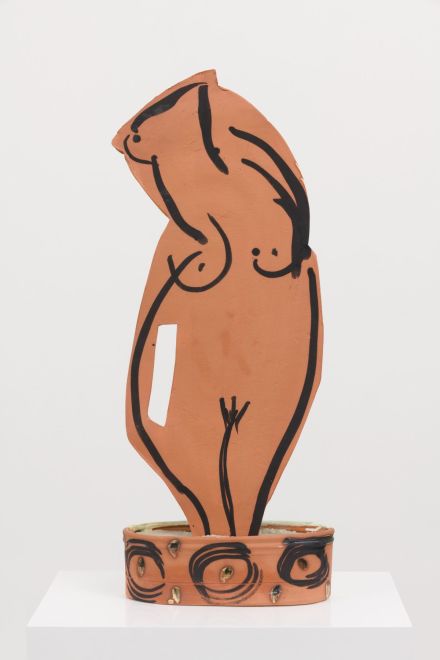
Betty Woodman, Venus #7: Homey (2014), via David Kordansky
Currently on at David Kordansky’s Los Angeles exhibition space, Shadows and Silhouettes brings together a selection of sculptures and paintings by Betty Woodman, the artist’s first solo show in a gallery since her death. Meandering through the last years of the artist’s live, the show takes particular interest in the technical issues of constructing the work, and how these moments and movements in space can work in conjunction with the artist’s hand to complete the object.
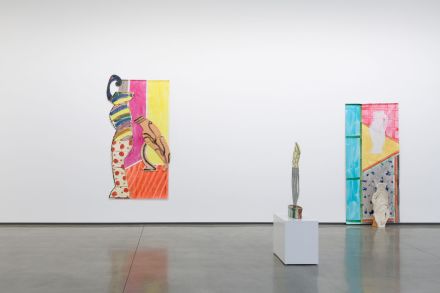
Betty Woodman, Shadows and Silhouettes (Installation View), via David Kordansky
The show’s various themes and concepts, creative use of negative space, two- and three-dimensional representations of vessels, the hybridization of vessel and human figurative forms, were longstanding interests for the artist. Over the course of a career that spanned more than 50 years, she would pioneer a range of innovations and explorations of clay and glazes in contemporary art, working through various iterations and investigations of the ceramic as a sculptural material, and its tactile qualities. Over the course of the 12 works on view, one can trace the artist’s sense for her materials growing ever more exploratory, and the focus of the show juxtaposes varied works in which painted and sculpted forms are repeated and reversed, and in which outlines of objects carve out negative spaces that re-appear as pictures either on canvases or glazed onto the objects themselves. These are energetic exercises in mirroring and echo, operations of improvisation and repetition that turn each of her works into subtle inversions and reworkings of subject matter. They range from classic pedestal-based sculptures like the diptych His and Hers Vases: Life Drawing (2008)––whose standing and reclining female nudes are painted with black and white glazes on vertically- and horizontally-oriented vases––to the Cubist complexity of Aztec Vase & Carpet: Mariana (2015), whose canvas “base” and dynamic, four-winged vessel provide surfaces for a continuously painted and glazed composition of alternating dark and light squares, among other motifs.
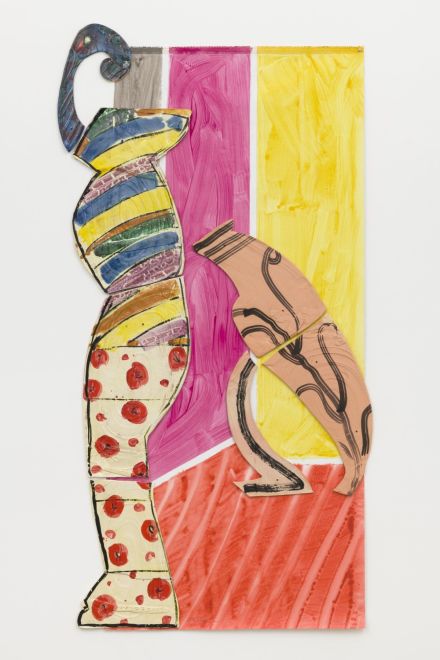
Betty Woodman, Lady and Leaning Vase (2011), via David Kordansky
For Woodman, pictorial and sculptural versions of space were in constant conversation with one another. These conversations could be harmonious, dissonant, humorous, or soaring and poetic, depending on their context. The Chapel, a large painting with ceramic relief elements from 2011, is in the latter mode: flat ceramic elements, glazed a brilliant white, are arranged on the wall so that they resemble tall, multipart vases. The canvas on which they hang has been painted with slashing white brushstrokes against a black background. This optically dynamic play of two-dimensional volumes is accentuated by the dramatic three-dimensional composition defining the work’s upper third, where a vessel with bright red glazing sits on a white shelf and another group of relief objects hover over the illusionistic, painted rendition of a room characterized with an intense red floor and yellow walls.
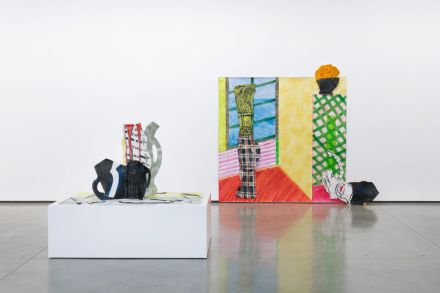
Betty Woodman, Shadows and Silhouettes (Installation View), via David Kordansky
Works like these reflect the increasingly daring ways that Woodman employed architectural imagery, harnessing both the capacities of her material and her knowledge of its limits as a way to build emotive and deftly balanced works that pull the viewer through a range of expressive states. Considering the repetitive nature of the works’ surfaces in tandem with these, Woodman’s last years seem to create a world of their own, an internalized logic that allows the viewer to pass through a set of objects and scenes that turn corners and open new doors while remaining tied to a familiar logic.
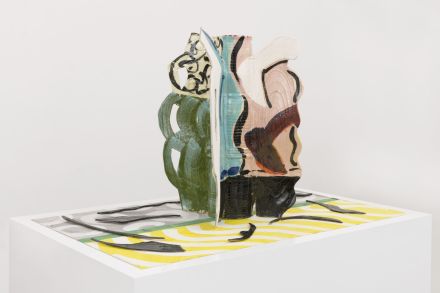
Betty Woodman, Aztec Vase and Carpet #7 (2014), via David Kordansky
— C. Rhinehart
Read more:
Betty Woodman: Shadows and Silhouettes [Exhibition Site]



